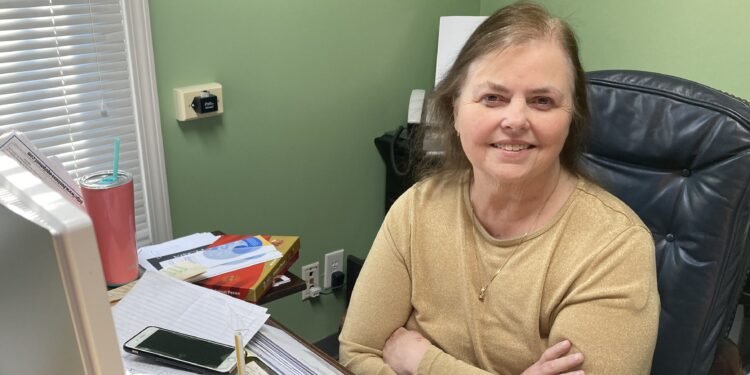Sometime in January when Anita Mindrup-Ivie walks out the door of the Father Bradley Shelter for Women and Children, she’s going to be trying something new.
For the first time since about age 15, the shelter director won’t have job responsibilities. She’s going to work at retirement.
Mindrup-Ivie will be leaving a position she’s had for the past nearly seven years after having been in private law practice for a number of years, working as an assistant Commonwealth’s Attorney during which she handled both criminal and civil cases and serving a term in Henderson County on the 51st District Court bench as a judge.
But the life-long resident of Henderson County came full circle the first time she was thinking about retirement and was recruited by the Father Bradley shelter board to run the facility.
It was a logical choice, said board member and fellow attorney/judge Sheila Farris, noting the shelter director’s educational background and previous work experience
Before Mindrup-Ivie earned her law degree from Chase College of Law at Northern Kentucky University, she received a Bachelor of Arts degree from University of Kentucky in social work (with an emphasis in criminal justice) and became a social worker for the state of Kentucky, devoting her attention to juvenile cases. She also worked as a social worker at a nursing home.
She said taking the leadership role at the shelter and having the opportunity to work at helping people was a “humbling” experience for her.
“(When they arrive) most of the ladies don’t own anything. They come in with just a sack with most of their belongings,” Mindrup-Ivie said.
She notes that the potential to thrive is aided by the family environment at the shelter, which can comfortably accommodate 22 residents.
“A lot of the ladies who come here don’t have much family support,” the director said. “They get to be friends with the other ladies and that gives them a bond.”
When children come along to the shelter with their mother, they automatically acquire new “aunts” who help prepare after-school snacks and homework help, she said.
Mindrup-Ivie said she has personally encountered many heart-warming stories about the difference the shelter was able to make in someone’s life during her tenure, including one woman during the pandemic who was brought to them by an out-of-town probation officer and hadn’t had a COVID test.
The officer was inclined to drop the woman on the street and let her fend for herself. But Mindrup-Ivie insisted that she be taken for a COVID test then returned to the shelter
“She was so grateful that we didn’t just turn her out,” the director. “When she arrived she felt like she had been turned out like trash, but we saw her as a person. She had so much more self-esteem when she left. She was so grateful for the Father Bradley shelter.”
Mindrup-Ivie noted that she honestly doesn’t know where the women would go if the shelter didn’t exist to offer a safe haven and an opportunity to get back on their feet.
“When they call us they are desperate,” she added. “They don’t have family, they don’t have material goods, they don’t have much hope. But they can come here and we don’t judge them. We counsel.”
She said the residents are required to get a job within the first two weeks and save 65 percent of their income.
Dr. Tim Hobbs, chairman of the Father Bradley shelter board of directors, said members are grateful to Mindrup-Ivie for “the compassionate expression of Christian love that she has shown those who find themselves in need of shelter and stability.”
“Our mission is to offer hope to those who may find hope hard to come by,” Hobbs added. “Anita has offered this hope admirably for the past 6 1/2 years. We applaud her service and wish her the best in her retirement as we continue to work toward a great future ahead.”
Though her job is a 24-hour one, it’s one that provides a great deal of self-satisfaction, Mindrup-Ivie said.
“You’re doing something to help people,” the director explained, “and that’s been very fulfilling to me.”
She said she’s not in a big rush to walk out the door and has pledged to stay on long enough after her replacement is selected to assist with training. She has made no firm plans yet for the next phase.
“But it seems like the right time to retire,” Mindrup-Ivie said. “It will be nice to spend more time with my family.”




















